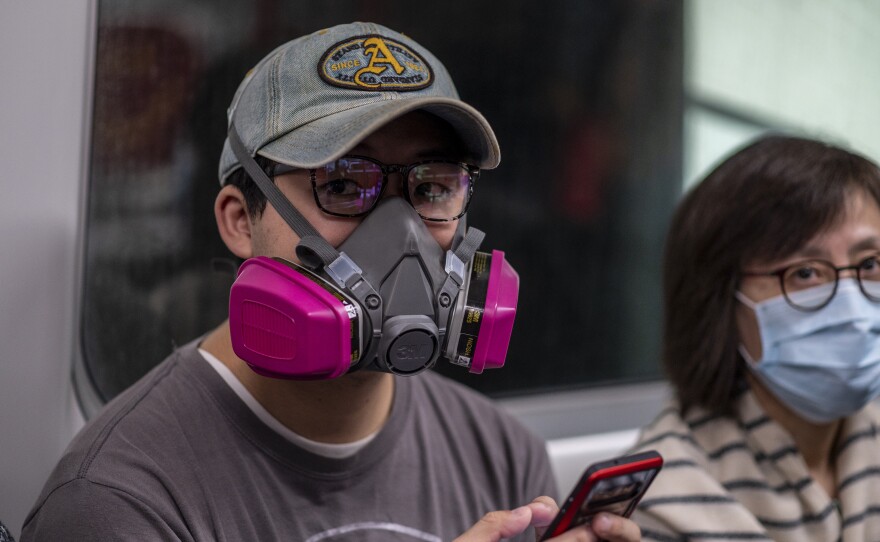As the U.S. and much of the world deals with the arrival of COVID-19, one place that's managed to limit the spread of the disease is Hong Kong.
Hong Kong sits right up against China's Guangdong Province, which has had more than 1,300 cases, the second largest number on the mainland after Hubei.
But Hong Kong has seen fewer than 100 cases since the outbreak began, and so far its strategies to contain the coronavirus have prevented large-scale outbreaks that have happened in countries like Iran, Italy and South Korea.
The suppression of the disease in Hong Kong, however, has come at a steep cost to the city.
Schools are closed. Many businesses are shuttered. All train, bus and ferry service to mainland China is suspended, and the border with China is essentially shut down.
People keep their distance from each other. Almost everyone on the street wears a surgical mask. Some even wear gas masks. Few people shake hands.
And some residents are hunkering down in their apartments.
In the North Point neighborhood, 48-year-old Carina Zhang says she only ventures out once or twice a week to buy vegetables and other perishable groceries. When she does go out, she tries to not have any skin exposed in an effort to protect herself against the virus. She wears a face mask, wraparound sunglasses and a large cloth hat that flops over her ears and shields much of her face. Finally she slips on disposable plastic gloves that she tapes around her wrists.
"And when I return home I wash immediately," she says. She washes her hair, her clothes. Everything, she says.
She hasn't allowed her 8-year-old son or her live-in housekeeper to leave her apartment for weeks, she says. Zhang quickly adds that she pays her maid extra as a result of her no-leaving-the-house rule.
Zhang's self-isolation is similar to the way millions of people are living in locked-down cities in China right now, but it's more extreme than what most people in Hong Kong are doing.
The centerpiece of Hong Kong's containment strategy is aggressively tracking down suspected cases and quickly quarantining anyone who's potentially been exposed. At one point in February, the city had nearly 12,000 people in various forms of quarantine. Some are held in what used to be summer camps, others in a just-completed complex of public housing towers. Some are electronically monitored at home.
"I think Hong Kong is an excellent example of why we can think that these methods work," says Keiji Fukuda, who helped lead the World Health Organization's response to the West Africa Ebola outbreak. Fukuda is now the director of the School of Public Health at the University of Hong Kong.
"Just a few miles away across the border, we have much larger numbers of cases," Fukuda points out. "And yet in Hong Kong, we see that over the past five weeks or six weeks the number of cases has remained remarkably small. So I think [Hong Kong] is a really good example where I believe that we're seeing [that] social distancing measures, personal hygiene measures really, really work."
To try to contain the spread of the virus, officials from the Hong Kong health department every day announce the addresses and occupations of people newly diagnosed with COVID-19. And then they call on residents who may have had contact with those people to come forward.
But obstacles loom. At a press briefing last week, Dr. Chuang Shuk-kwan, head of the communicable disease branch of the Hong Kong health department, lamented that her department was having trouble connecting with people who may have been exposed to the virus at a Buddhist temple where several visitors had tested positive and where the virus was also found on prayerbooks and the bathroom faucet.
"For the temple unfortunately we don't have a list [of people] because there's no registration."
In addition to prayer services, the temple offered free meals to elderly residents, but it had no record of who had come to eat. In this instance, dozens of people who'd been there called the health department's coronavirus hotline.
"And so we contacted them," Chuang says, "categorized them into close contacts [of earlier cases] and those who have passed their incubation period. We put around 16 of them under quarantine and about 100 of them under medical surveillance."
That same day Chuang's department was trying to find spaces in the city's already overstretched quarantine centers for 59 police officers. The cops had all attended a going away banquet with an officer who reportedly was feverish with COVID-19.
Dirk Pfeiffer, a veterinarian at City University of Hong Kong who studies emerging infectious diseases, says he thinks the city has handled the outbreak reasonably well. But Pfeiffer is troubled by the way the outbreak is dominating life in Hong Kong and causing so much fear.
"I find that disturbing," he says. "Because I don't think our reaction is proportionate to the impact it has on human health."
He points out that in the first two months of this outbreak two people in Hong Kong died from COVID-19 while more than 100 died from the flu.
"At the moment, I worry that everything is focused on COVID-19," he says. "Certainly here in Hong Kong, there's people that turn up [at hospitals] with other ailments or diseases, and it's difficult for them to get into the emergency wards. We need to get the balance right."
As more and more countries grapple with COVID-19, they're going to have to try to get that balance right too.
Copyright 2020 NPR. To see more, visit https://www.npr.org.






